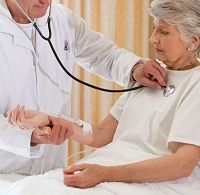Identifying Patients Before They Need the ICU
"A lot of us know that, essentially, if you don't rescue the patient from falling off a cliff, there's a negative patient outcome," Nathan Boyer, CPT (P), MC, from the Brooke Army Medical Center in Texas, began a presentation at the CHEST 2015 meeting in Montréal, Canada.

“A lot of us know that, essentially, if you don’t rescue the patient from falling off a cliff, there’s a negative patient outcome,” Nathan Boyer, CPT (P), MC, from the Brooke Army Medical Center in Texas, began a presentation at the CHEST 2015 meeting in Montréal, Canada.
The rapid response system (RRS) is used to identify patients with early signs of deteriorating health before they have to be moved to the intensive care unit (ICU). Boyer and colleagues analyzed how formal RRS training can improve emergency calls and code blue rates. In addition, they tried to increase the utilization of the system — which can be used for countless conditions including chronic obstructive pulmonary disease (COPD).
The team gathered data from before and after the initiation of the RRS training. The training was made up of an hour-long lecture, online training, and marketing campaign for surgical wards. The Rapid Response Team (RRT) included a critical care nurse, respiratory therapist, the patient’s primary nurse, and responsible provider (or a Medical Intensive Care Unit (MICU)/Surgical Intensive Care Unit (SICU) fellow as backup).
From January to August 2014, the average number of calls was 39 (17 per 1,000 hospital discharges). Data following the RRS training, September to December 2014, revealed that the average number of calls rose to 123 (58 per 1,000 hospital discharges). The increase may be disconcerting, but it’s actually a positive thing.
“The main thing to look at is the rates of people transferred to higher level of care,” Boyer pointed out. While the amount of calls climbed, the number of people sent to the ICU did not. Since the RRT was called in more cases, they were able to assess the situation before a higher level of care was needed. Therefore, they were able to determine that admission to the ICU was not actually needed in some scenarios.
“Initially there was a negative reaction by house providers,” Boyer noted, due to the increase in responses. However, the surge actually helped lower ICU admissions.
Before the training, 45% of patients were transferred to higher level of care and that dropped to 34% after the initiation. Notably, the top two reasons for RRS initiation were tachycardia (27%) and hypertension (23%) and the greatest increase in calls was observed soon after the training took place.
Boyer explained that it was good to have a critical care nurse on the team to administer beta-blockers or other bedside treatments that could stabilize the patients and prevent ICU transfers.
“Emergency intervention can reduce emergency rescues,” Boyer said. The team is now looking into the data to pinpoint length of stay and mortality rates. But according to the information gathered thus far, the number of mortalities remained consistent between 2014 and 2015. This may lead clinicians to question whether the system is even worth continuing. Sandra Willsie, DO, one of the moderators of the CHEST 2015 session, jumped in and said that with ICU beds being scarce, the system is still helping even if it’s not reducing mortality.